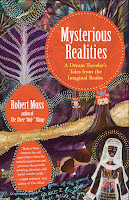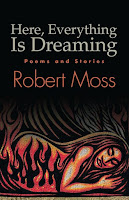At my
workshop at the Hameau de l'Etoile in April, 2016 , a hoopoe tapped five
times on the window behind my head. We don’t see hoopoes where I live, in North
America, but I know the bird well from mythology.The hoopoe, with its crown of feathers, is a royal and magical bird in its normal plumage, with a grand role in the folklore and sacred stories of the East. Hoopoes were messengers between Solomon and the Queen of Sheba. In The Conference of the Birds, a great Persian tale of mystical ascent by the poet Farid ud-din Attar, it is the hoopoe that calls the birds together to embark on the quest for the King. In the quest, the birds who survive the journey fuse together as the Simurgh, the bird of heaven. In our meeting room in southern France, I knew
I was fluttering on the mythic edge.
My
workshop was titled Becoming a Kairomancer. I invented the word “kairomancer”
to describe a master of special moments, an everyday magician forever poised to
recognize special Kairos moments of synchronicity and celebrate than and act on
the opportunities they present. In such moments, we sometimes feel that powers
from a deeper reality are tapping on the windows of our ordinary perception to
encourage us to open to a larger life and the play of forces beyond our
consensual hallucinations. I felt this as the hoopoe tapped, and tapped again
and again, as I told the group about its role in bringing the birds together to
make the heaven bird.
Chansons, I
concluded my tale. Let's sing.
Flights of the Simurgh
There are mythic
beings that roost in the mind, ready to seize your imagination and carry you
off on wild adventures: dragons, griffins and other fantastic beasts. Some may
stay with you for a whole lifetime, and may remind you of other lifetimes. I
can’t remember when I first heard the name of the Simurgh, but I know I have heard its cry and felt the wind of its wings
long before naming.
Jorge Luis Borges was
also fascinated by the mystical bird of Persian mythology. He wrote an essay
reflecting on the mystery of how, in The Conference of the Birds,
thirty birds become one bird, while the one bird is still thirty. He quotes
these astonishing lines by his fellow-Argentine poet, Silvina Ocampo:
Era Dios ese pájaro
como un enorme espejo:
los contenía a todos; no era un mero reflejo.
En sus plumas hallaron cada uno sus plumas
en los ojos, los ojos con memorias de plumas
This bird was God,
like an enormous mirror
that contained them all, and not a mere reflection.
In his feathers each one found his own feathers,
in his eyes, their eyes with the memories of feathers.[1]
When I found this, my memories stirred of one of the big dreams
of my life. In the dream, back in 1988, I found myself in a house on a
canal, perhaps in Amsterdam. The house belonged to a magician. I sampled the
rich library. On a large table in another room, under glass, I found an
elaborate machine signed by Israel Regardie, who disclosed the secret rituals
and "flying rolls" of the Hermetic Order of the Golden Dawn.
Upstairs, in the
master bedroom, I found a Persian rug, lying on the bed. Still rolled and tied
with strings, it seemed to have been recently delivered, and still unused, at
least in this house. While I contemplated the rug, a shamanic teacher with whom
I had studied entered the room behind me. He was immensely excited by the rug,
wanting to know when it had been delivered and when and how I planned to use
it.
I woke excited, with
many questions. The first was: who is the owner of this house? Instead of
speculating on this theme, I reentered the dream, with the aid of shamanic
drumming, to make a full tour. I discovered what you might have guessed, had
you heard my initial report. The house on the canal was my own, a place where I
could explore my connections with many traditions of inner work and practical
magic with which I appear to have connections across space and time. I went
carefully through several volumes in the library. I examined the Golden
Dawn machine. It was antiquated, with unnecessary Heath Robinson features, but
still in fine working order.
Then I went up the
stairs to the bedroom and unrolled the Persian rug. I marveled at the beauty of
the design. It was woven in colors of blue and silver. At the center was the
form of a great bird I knew to be the Simurgh. When I spread out the rug, the
Simurgh rose and spread its great wings. I found myself instantly on its back.
We made a wild ride across space and time. I was drawn into the world and the
visions of the Magi, and saw Bethlehem as they visioned it. I found myself
chanting ancient names in Farsi. My mind opened to memories of the Fravarti,
the Choosers, spiritual knights of Persian tradition who make the choice to
leave a higher world to come into this one to fight a good fight.
Over the years
that followed my discovery of the Persian rug in the house on the canal, I
received visitations in the twilight zone between sleep and awake that prompted
me to deepen my study of Persian mystical traditions. A name that was mentioned
again and again was that of Suhrawardi, the great medieval mystical philosopher.
On a night that opened like a flower, I felt a radiant presence in my room.
Rise from
your body, and I will descend to you.
I loosened physical
focus without separating from the body. I had the impression of a handsome
young man of Persian appearance, wearing modern clothes, a suit and a shirt
with banded collar. He said that his name was Shams. He told me, “Suhrawardi is
the key to your understanding of the dream cosmos,” and that I should use his
geographies of the Imaginal Realm. “Go to Mount Qaf.”
I read translations of
Suhrawardi’s works, and books about him by the French scholar Henry Corbin. I
read about a mystical journey through the realm of the moon to a tree bearing
all fruits on a high peak of the world mountain, Mount Qaf. In that tree is the
nest of the Simurgh.
I stretched out on my
bed, in an early dawn, and was transported into this scene:
I am in a palace that
is open to the winds, a place of soaring arches. It does not seem to stand on
earth, but among the stars. It is roofless, open to the night sky, which is
dark yet light at the same time, shimmering in every particle. There are twelve
spacious rooms in the palace. Each contains marvelous musical instruments,
shaped like butterfly wings. Some have multiple wings or leaves. They resembled
stringed harps, yet the “strings” are so fine as to be invisible. Cosmic winds
blow celestial harmonies through these wings of sound. I marvel at the beauty
of these harmonies.[2]
In one of Suhrawardi’s visionary treatises, I found the Simurgh with its wind
and music:
“This
Simurgh flies without moving, and he soars without wings. He approaches without
traversing space. All colors are from him, but he himself has no color. His
nest is in the orient, but the occident is not void of him. All are occupied
with him, but he is free of all. All are full of him, but he is empty of all,
All knowledge emanates and is derived from his shrill cry, and marvelous
instruments such as the organ have been made from his thrilling voice….His food
is fire, and whoever finds one of his feathers to his right side and passes
through the fire will be safe from burning. The zephyr is from his breath,
hence lovers speak their hearts’ secrets and innermost thoughts with him.” [3]
I
went on a quest to find an image of the Simurgh as it appeared on the magic
carpet in my dream of the house on the canal. I found many pictures over the
years, but failed to find the silver and blue heaven bird that took flight in
my dream.
I have Peter Sis' beautiful
illustrated and simplified version of The Conference of the Birds. There is a lovely picture of thirty birds joined in the
form of a giant bird in full flight, but not the colors from my dream.
[3]
I
mounted yet another online search and hit gold, or rather, silver. The mosaic
in the photograph shows the Simurgh in the colors of my
dream. The mosaic is on the wall of Nadir Divan-Beghi madrassah, Bukhara, Uzbekistan
.jpg)
As I was writing this blog, the hoopoe tapped me again, in the pages of a novel I picked up for now particular reason except that I like the word oracle and was teaching Istanbul in that period. In Michael David Lukas’s novel, The Oracle of Stamboul, the very young protagonist (a child savant from Constanta, Romania) is accompanied everywhere by a flock of hoopoe birds distinguished by their unusual color. They are light purple rather than brown. I learned that hoopoes are are renowned in Turkey today for the ability to see the unseen, for example, to locate underground sources of water. Hard to miss messages when storied birds come so gorgeously arrayed, literally tapping at the window or circling around your head. In The Oracle of Stamboul, the hoopoes help to give a little girl the ear of a Sultan, no less.
When synchronicity strikes, the universe becomes personal and we may sense a hidden hand, reaching through the veils of ordinary perception to tickle or tap us awake. For me, this sequence, playing in dreams of the night and dreams of the day over decades, is confirmation that we are called beyond our current identities to traditions
and lineages that may be part of our larger, multidimensional story.
References
1. "The Simurgh and the
Eagle" by Jorge Luis Borges is one of his "Nine Dantesque
Essays" reprinted in Selected Non-Fictions, edited by Eliot
Weinberger (New York: Penguin, 2000). The Silvina Ocampo poem is Espacios métricos, 12.
2. For more on own adventures
in these realms, please see The Boy Who Died and Came Back chapter 38, "Flights of the
Simurgh"
3. Peter Sis, The Conference of the Birds (New York: Penguin
Books, 2013)
4. Shihabuddin Yahya Suhrawardi, “The Shrill Cry of the Simurgh” in
W.M.Thackson, Jr. (trans) The Mystical and Visionary Treatises of
Suhrawardi (London: Octagon Press, 1982) p.88
Journal drawing: "Tap of the Hoopoe" by Robert Moss





.jpg)

.jpg)


























